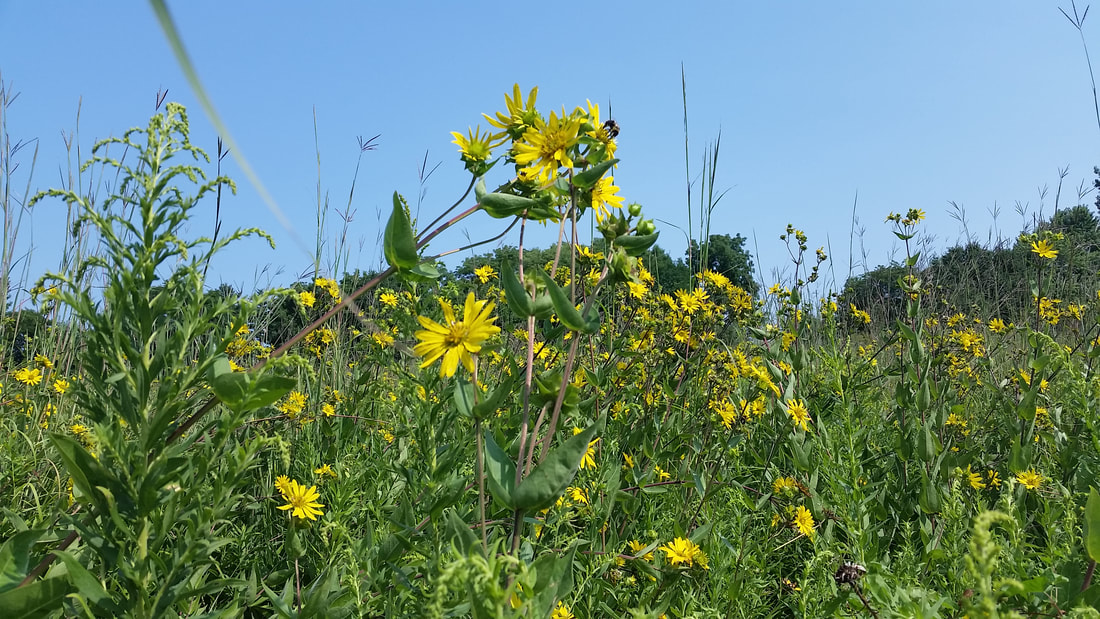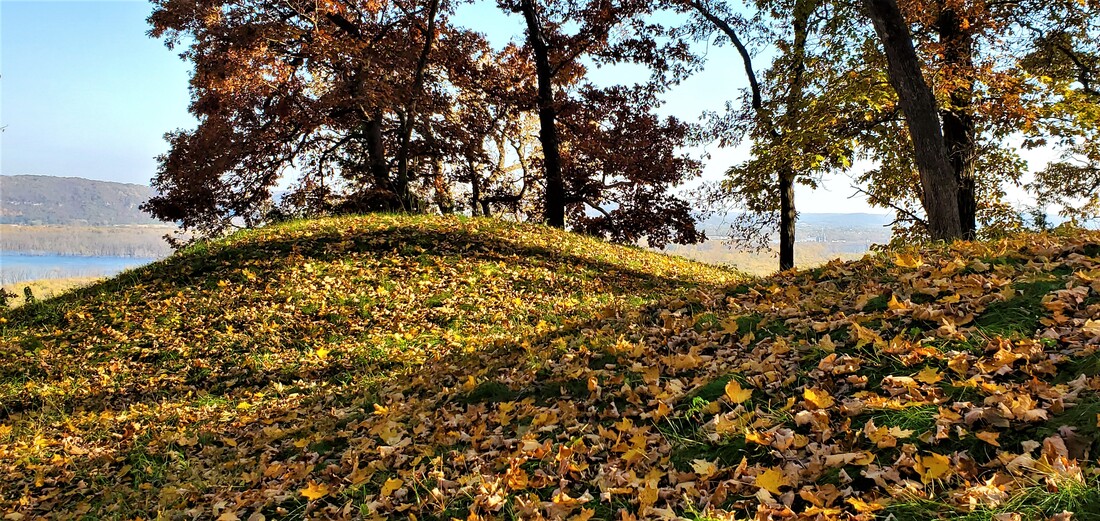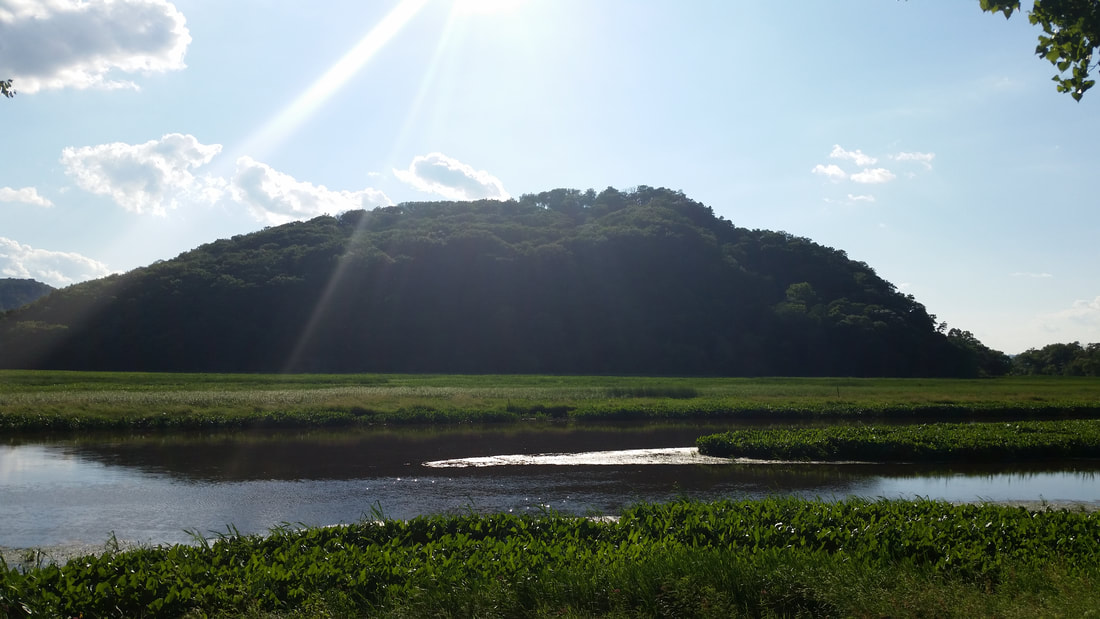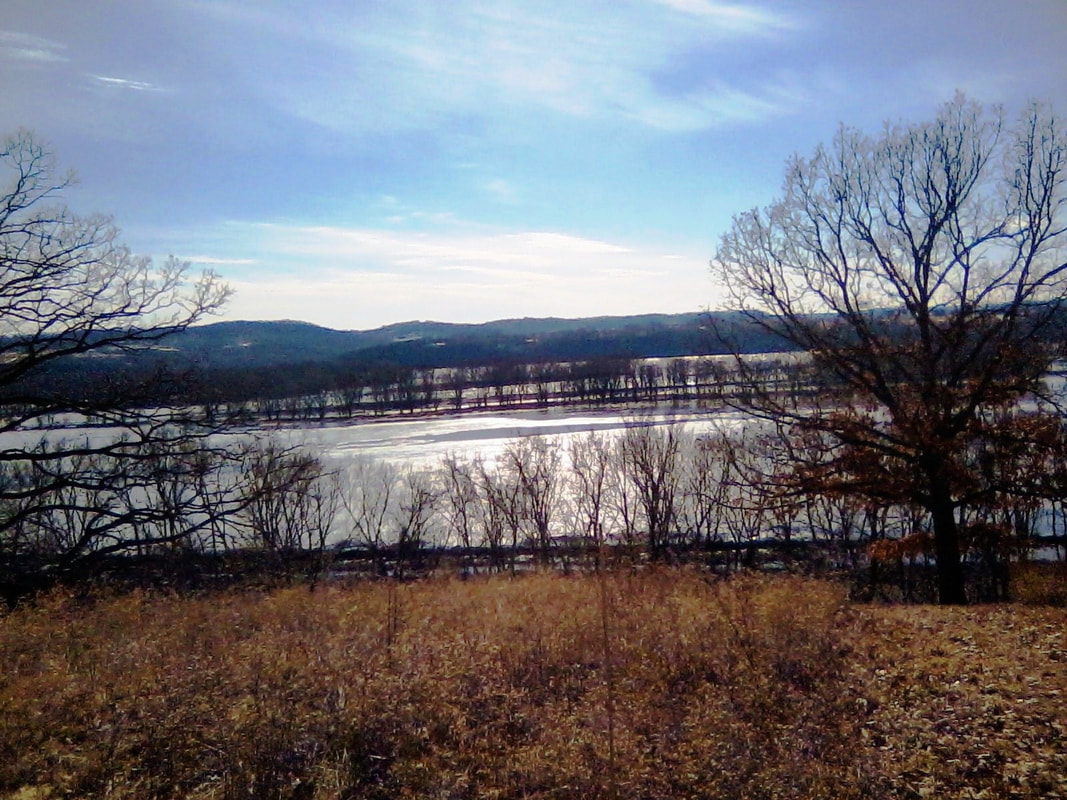It was “Bonfire on the Bluff” night at Casper Bluff south of Galena, IL, an archaeological site of 38 Native American conical and linear mounds—including one magnificent Thunderbird mound—cared for by the Jo Daviess Conservation Foundation. Candles placed along the trails ushered night-time visitors to blufftop views of the Mississippi brooding beneath.
The bonfire was near, but respectfully distanced from, an elliptical Native American earthwork constructed between 700-1000 AD. Earthen enclosures like this were used for rituals, dances, and gathering spaces.
That night amid the candle-lit trails, we were not the first to revere and admire the mighty river. Native American burial mounds constructed during the Woodland Period from 200 -1100 AD dot the length of the Mississippi in the Driftless Area along, attesting to the long draw of the sacred river. Human presence along the river dates back 10,000 years, long before mound-building began.
It occurred to me then how many mound sites I had visited over the years, all within 250 river miles.
Furthest north on my personal list is Perrot State Park just north of Trempealeau, WI, home to more than a dozen mounds. A trail rising 500 feet above the river culminates at Brady’s Bluff, where several extraordinarily-preserved mounds tower above the river.
Above the town of Trempealeau, archaeologist Ernie Boszhardt once showed me platform mounds constructed by Native Americans from Cahokia (near today’s East St. Louis), who were moving up the river during the Mississippian period, around 1100 AD.
Downstream from Trempealeau lies Effigy Mounds National Monument near Marquette, IA. I can’t count the number of times I’ve been there. In one of the most significant Native American sites in the nation, Effigy Mounds preserves almost 200 burial and ceremonial mounds, 29 shaped as bears and raptors.
My most recent visit was with a friend who’d not been there before. We hiked to the Marching Bears formation featuring ten bear-shaped mounds arranged head-to-tail in single file pointing southward 450 feet above the Mississippi. Three raptor effigies accompany the bears, their wings spread as if in flight and their heads pointed toward the river beneath the bluff. Two of the raptors scout out ahead of the marching bears while the third corrals the rearmost into line. The largest bear measures 137 feet from nose to tail, and the largest bird’s wingspan is 212 feet.
Burial and ceremonial mounds were meticulously constructed. Burial chambers were dug into the landscape, and mound soils of varying types and textures carefully layered above to withstand erosion through the ages. Soils from the river bed were carried basket by basket up the bluff trails—perhaps the very one we’d hiked—to be placed upon the mounds, suggesting the sacred regard given to the Mississippi.
While most such burial mounds are located on bluffs above the river, the Effigy Mounds Sny Magill Unit lies at river level, several miles south of the bluff-top mounds. Here 100 conical, linear and effigy mounds have withstood a thousand years of repeated flooding. When I returned from a three-month stay in Ireland a few years ago, on my first day home I walked amid these mounds with my wife Dianne to reorient myself to my own sacred places.
On Dubuque’s north side, 32 mounds grace the Little Maquoketa Burial Mounds site on a bluff a short distance from the Mississippi. East Dubuque is home to the Dunleith mounds, where four magnificent burials keep watch over the Mississippi. Prairie restoration at the site has returned the mounds to their original look. These mounds are clearly visible on the Illinois bluff when driving east across the Julien Dubuque bridge.
I have encountered burial mounds in the bluffs at the Mines of Spain. Once, on a woods hike by myself, I came upon a depression I assumed was a lead mine of the type the Mines is known for. But when I spied three adjacent mounds, I had a sinking feeling that the depression was a long-ago desecration of the grave. But I have no way of knowing.
I’ve taken students hiking at Bellevue State Park. The northern end of the bluff offers an iconic overview of the town and the lock and dam alongside it. A southern overlook is reserved for burial mounds scanning the Mississippi.
The river bluffs above Albany, IL, harbor 26 mounds constructed between 200 BC and 300 AD. The mounds are located in a 205-acre state historical site of woods and prairie.
The Black Hawk State Historical site in Rock Island memorializes the Sauk village that prospered there before the 1832 Black Hawk War. But it also preserves burial mounds that long pre-date the village. I once visited these mounds before retracing, by car, the 500-mile trek of Black Hawk War.
No doubt I have overlooked many mound groups, and I have not even mentioned mound locations away from the Mississippi. These are merely the ones I have visited along a 250-mile swath of sacred river.
Just before it was dark enough for the bonfire at Casper Bluff, Dianne and I gazed quietly at the Mississippi from a bench among the mounds. From here it was easy to imagine sacred burial mounds once lining the length of the river.
And why not? In Dubuque the Linwood and Mt. Calvary cemeteries lie near the Mississippi as well. Hasn’t the river mesmerized us for 10,000 years?
I try to be cognizant of cultural appropriation these days. I make no assumptions about the lives and ways of the indigenous peoples who built these mounds. Instead, I focus on what I believe we hold in common, though it often bears repeating, reminding, and re-teaching.
That the land that holds our dead is sacred.
That the land that bears and cradles our lives is sacred.
That sacred lands be treated with reverence.
-- February 2020
 The Albany Mounds are located in a 205-acre woods and prairie State Historical Site in Albany, IL.
The Albany Mounds are located in a 205-acre woods and prairie State Historical Site in Albany, IL. 


